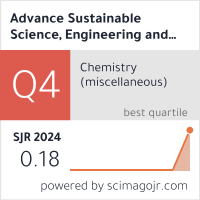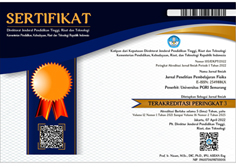Mechanical Performance of Alkali-Treated Rattan Strips with Epoxy Coating for Sustainable Composite Applications
DOI:
https://doi.org/10.26877/asset.v7i3.2017Keywords:
natural fiber composites, sustainable materials, green materials, bio-composites, surface treatment, green engineering, rattan stripsAbstract
The use of natural materials like rattan in eco-friendly composites is gaining attention in materials engineering. However, its hydrophilic nature and interaction with other materials can affect mechanical strength. This study investigates how variations in rattan size and alkali treatment influence the tensile properties of single rattan strips through an epoxy dipping process. Rattan was prepared with varying lengths (5–15 cm), widths (3–8 mm), and a consistent thickness (0.5 mm). Alkali treatment used 5% and 10% NaOH concentrations for 1 and 24 hours. Tensile testing showed that a 5 cm × 8 mm strip achieved the highest tensile strength (49.95 MPa), Young's modulus (3562.77 MPa), and low strain (5.4%), while the 15 cm × 3 mm strip had the lowest strength (9.48 MPa) and modulus (475.69 MPa) with higher strain (10.32%). A 5% NaOH treatment for 24 hours improved adhesion and performance, while 10% caused degradation.
References
[1] K. Krisdianto, J. Jasni, and T. Tutiana, “Anatomical properties of nine indigenous rattan species of Jambi, Indonesia,” Indones. J. For. Res., vol. 5, no. 2, pp. 147–161, 2018.
[2] R. Wahab, N. Mokhtar, R. S. Mohd Ghani, and M. S. Sulaiman, “An Overview of Rattan Industry Status and Its Economic Aspect in Setting Up Rattan-Based Industry in Malaysia,” e-BANGI J., vol. 16, no. 3, 2019.
[3] Afentina, P. McShane, and W. Wright, “Ethnobotany, rattan agroforestry, and conservation of ecosystem services in Central Kalimantan, Indonesia,” Agrofor. Syst., vol. 94, no. 2, pp. 639–650, 2020.
[4] S. K. Sahoo et al., “Fabrication and characterization of acrylic acid treated rattan fiber reinforced polyethylene terephthalate composites for packaging industries,” J. Nat. Fibers, vol. 19, no. 13, pp. 5768–5781, 2022.
[5] Y. Gu and J. Zhang, “Tensile properties of natural and synthetic rattan strips used as furniture woven materials,” Forests, vol. 11, no. 12, p. 1299, 2020.
[6] S. Yang, E. Xiang, L. Shang, X. Liu, G. Tian, and J. Ma, “Comparison of physical and mechanical properties of four rattan species grown in China,” J. Wood Sci., vol. 66, no. 1, p. 3, 2020.
[7] S. K. Sahoo, J. R. Mohanty, S. Nayak, and B. Behera, “Chemical treatment on rattan fibers: durability, mechanical, thermal, and morphological properties,” J. Nat. Fibers, vol. 18, no. 11, pp. 1762–1771, 2021.
[8] D. Bachtiar et al., “Effect of alkaline treatment on the thermal and mechanical properties of sugar palm fibre reinforced thermoplastic polyurethane composites,” Sci. Rep., vol. 15, no. 1, pp. 1–14, 2025, doi: 10.1038/s41598-025-99227-x.
[9] M. H. Hamidon, M. T. H. Sultan, A. H. Ariffin, and A. U. M. Shah, “Effects of fibre treatment on mechanical properties of kenaf fibre reinforced composites: a review,” J. Mater. Res. Technol., vol. 8, no. 3, pp. 3327–3337, 2019.
[10] D.-H. Jeong, L. Xing, M. K. H. Lee, N. Vani, and A. Sauret, “Deposition and alignment of fiber suspensions by dip coating,” J. Colloid Interface Sci., vol. 650, pp. 407–415, 2023.
[11] G. Açıkbaş, “Interfacial and physico-mechanical properties of walnut shell fiber reinforced polyester matrix composites,” Mater. Test., vol. 60, no. 5, 2018, doi: https://doi.org/10.3139/120.111176.
[12] T. Cionita, R. Dewi, N. Sylvia, J. P. Siregar, and D. Fajar, “Effect of plasticizer and carboxyl methyl cellulose ( CMC ) on degradable plastics from rice straw and palm fiber,” vol. 12, no. March, pp. 478–494, 2025, doi: 10.3934/environsci.2025022.
[13] M. S. Sulaiman et al., “An economic study for rattan industry from raw materials to an enhancement of products development,” Math. Stat. Eng. Appl., vol. 71, no. 3, pp. 1819–1839, 2022.
[14] L. O. Cortat, N. C. Zanini, R. F. S. Barbosa, A. G. de Souza, D. S. Rosa, and D. R. Mulinari, “A sustainable perspective for macadamia nutshell residues revalorization by green composites development,” J. Polym. Environ., vol. 29, pp. 3210–3226, 2021, doi: 10.1007/s10924-021-02080-y.
[15] C. R. Álvarez-Chávez, D. L. Sánchez-Acosta, J. C. Encinas-Encinas, J. Esquer, P. Quintana-Owen, and T. J. Madera-Santana, “Characterization of extruded poly (lactic acid)/pecan nutshell biocomposites,” Int. J. Polym. Sci., pp. 1–12, 2017, doi: 10.1155/2017/3264098.
[16] Z. W. Ng et al., “Process design and life cycle assessment of furfural and glucose co-production derived from palm oil empty fruit bunches,” Environ. Dev. Sustain., vol. 25, no. 12, pp. 13937–13958, 2023, doi: 10.1007/s10668-022-02633-8.
[17] A. I. Imran et al., “Advancements in sustainable material development: A Comprehensive review of coir fiber and its composites,” Mech. Eng. Soc. Ind., vol. 4, no. 3, pp. 415–454, 2024, doi: 10.31603/mesi.12556.
[18] A. L. Cahyani, V. Linda, D. Guntama, M. N. Dewi, and L. Hakim, “Effect of Chitosan Variation in Starch and Cellulose Based Biofoam,” Adv. Sustain. Sci. Eng. Technol., vol. 5, no. 3, pp. 1–9, 2023, doi: 10.26877/asset.v5i3.17126.
[19] O. V Potadar and G. S. Kadam, “Preparation and testing of composites using waste groundnut shells and coir fibres,” in Procedia Manufacturing, Elsevier, 2018, pp. 91–96. doi: https://doi.org/10.1016/j.promfg.2018.02.013.
[20] G. B. Nyior, S. A. Aye, and S. E. Tile, “Study of mechanical properties of raffia palm fibre/groundnut shell reinforced epoxy hybrid composites,” J. Miner. Mater. Charact. Eng., vol. 6, no. 2, pp. 179–192, 2018, doi: 10.4236/jmmce.2018.62013.
[21] A. E. Uzoma, C. F. Nwaeche, M. Al-Amin, O. S. Muniru, O. Olatunji, and S. O. Nzeh, “Development of interior and exterior automotive plastics parts using kenaf fiber reinforced polymer composite,” Eng, vol. 4, no. 2, pp. 1698–1710, 2023.
[22] T. Setyayunita, R. Widyorini, S. N. Marsoem, and D. Irawati, “Effect of different conditions of sodium chloride treatment on the characteristics of kenaf fiber-epoxy composite board,” J. Korean Wood Sci. Technol., vol. 50, no. 2, pp. 93–103, 2022, doi: https://doi.org/10.5658/WOOD.2022.50.2.93.
[23] A. B. Rashid, A. M. Rayhan, S. I. Shaily, and S. M. M. Islam, “An experimental study of physical, mechanical, and thermal properties of Rattan fiber reinforced hybrid epoxy resin laminated composite,” Results in Engineering. Elsevier, 2024. [Online]. Available: https://www.sciencedirect.com/science/article/pii/S2590123024003074
[24] S. Sahu, S. Nayak, S. B. Sahu, and M. K. Roul, “Influence of various surface treatments on mechanical, thermal, morphological, and water absorption properties of rattan (Calamus beccarii) fiber,” J. Nat. Fibers, vol. 20, no. 1, p. 2125924, 2023.
[25] H. Wang, H. Memon, E. A. M. Hassan, M. S. Miah, and M. A. Ali, “Effect of jute fiber modification on mechanical properties of jute fiber composite,” Materials (Basel)., 2019, [Online]. Available: https://www.mdpi.com/1996-1944/12/8/1226
[26] J. Naveen, M. Jawaid, P. Amuthakkannan, and ..., “Mechanical and physical properties of sisal and hybrid sisal fiber-reinforced polymer composites,” … Compos. hybrid …, 2019, [Online]. Available: https://www.sciencedirect.com/science/article/pii/B9780081022924000217
[27] M. Bosquetti, A. L. da Silva, E. C. Azevedo, and ..., “Analysis of the mechanical strength of polymeric composites reinforced with sisal fibers,” … Nat. Fibers, 2019, doi: 10.1080/15440478.2019.1612310.
[28] S. Nayak, P. K. Rout, and P. K. Jena, “Investigation of mechanical, thermal and morphological properties of rattan fiber-reinforced polymer composites to produce lightweight material for automotive industries,” Therm. Adv., vol. 2, p. 100014, 2025.
[29] B. Koohestani, A. K. Darban, P. Mokhtari, E. Yilmaz, and E. Darezereshki, “Comparison of different natural fiber treatments: a literature review,” Int. J. Environ. Sci. Technol., vol. 16, pp. 629–642, 2019.
[30] A. Atiqah, M. Jawaid, M. R. Ishak, and ..., “Effect of alkali and silane treatments on mechanical and interfacial bonding strength of sugar palm fibers with thermoplastic polyurethane,” J. Nat. fibers, 2018, doi: 10.1080/15440478.2017.1325427.











